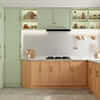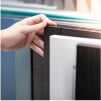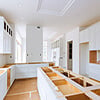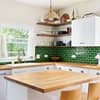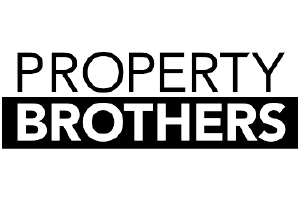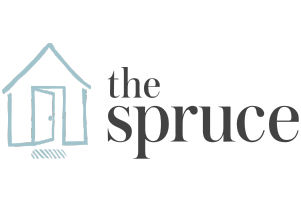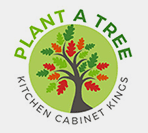11 Types of Cabinet Materials: From MDF to Stainless Steel
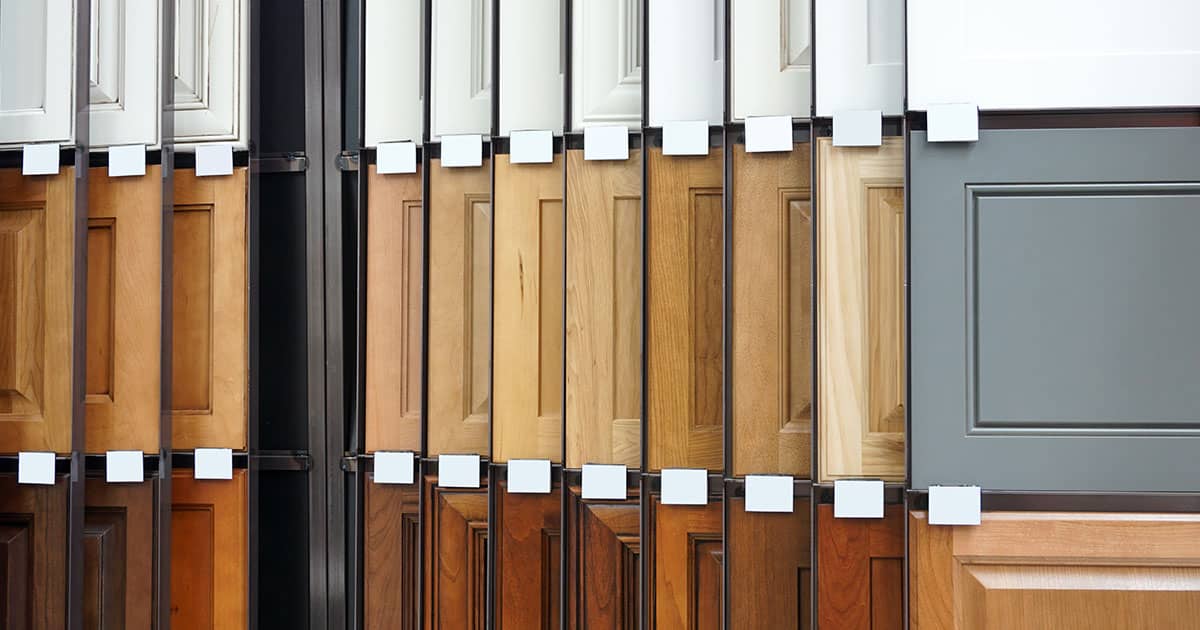
The kitchen cabinets you choose will be one of the most important decisions you make during a kitchen renovation. You want to choose quality cabinets in a style you love without breaking the bank. The type of cabinet material you pick should not only fit your remodeling budget, but your lifestyle as well.
Some kitchen cabinets will hold up better to clumsy cooks and counter-surfing dogs, but you may be able to settle for a more affordable material if you rarely use your kitchen. Before you decide on your next set of kitchen cabinets, read this guide to compare the quality, durability, appearance, and price of the most popular types of cabinet materials.
Table of Contents
Types of Cabinet Materials: Side-by-Side Comparison
| Material | Used For | Durability | Moisture Resistance | Heat Resistance | Price |
|---|---|---|---|---|---|
| Solid Wood | Entire Cabinet | High | Moderate | Moderate | $5,000-$25,000 |
| Plywood | Cabinet Core | High | Low | Moderate | $2,500-$8,000 |
| Medium-Density Fiberboard (MDF) | Cabinet Core | Moderate | Moderate | Low | $1,500-$5,000 |
| High-Density Fiberboard (HDF) | Cabinet Core | High | High | Low | $2,000-$7,000 |
| Particle Board | Cabinet Core | Low | Low | Low | $1,000-$4,000 |
| Laminate | Veneer | Moderate | Moderate | Low | Depends on core material |
| Melamine | Veneer | High | Moderate | Moderate | Depends on core material |
| Thermofoil | Veneer | Low | Moderate | Low | Depends on core material |
| Polyester | Veneer | High | High | High | Depends on core material |
| Wood Veneer | Veneer | Moderate | Moderate | Moderate | Depends on core material |
| Stainless Steel | Entire Cabinet | High | High | High | $25,000-$40,000 |
1. Solid Wood

Solid wood is the highest-quality type of kitchen cabinet material available due to its natural strength and durability. While solid wood cabinets are available painted, the natural color, grain, pattern, and texture are the main aesthetic draws of these types of cabinets.
Despite their impressive appearance and longevity, wood cabinets do have their drawbacks. For one, these cabinets are difficult to maintain compared to some of the manufactured materials available. They're prone to water damage and may fade or darken with sun exposure over time. Special cleaning solutions, proper sealing, and regular polishing are required to keep them in tip-top shape.
It may also come as no surprise that solid wood cabinets are the most expensive types of cabinets available. Depending on the quality and type of wood you choose, solid wood cabinets can range from $5,000 to $25,000 or more for a standard 10'x10' kitchen.
Pros:
 Luxurious natural appearance
Luxurious natural appearance Incredibly strong and durable
Incredibly strong and durable Can be easily refinished or repaired
Can be easily refinished or repaired Versatile
Versatile Can last decades when maintained properly
Can last decades when maintained properly
Cons:
 Expensive
Expensive Prone to warping and cracking from humidity or water damage
Prone to warping and cracking from humidity or water damage May fade or darken with sun exposure
May fade or darken with sun exposure Prone to termite damage
Prone to termite damage High-maintenance
High-maintenance
2. Plywood
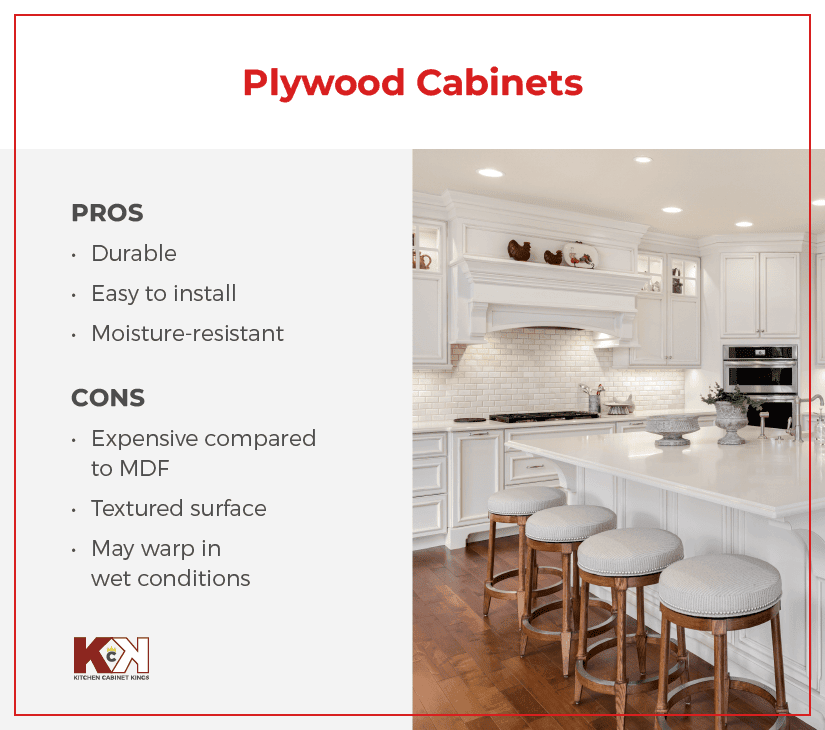
Plywood is a cabinet material manufactured using thin wood layers pressed together and finished with a veneer. This material is typically seen in higher-end stock or semi-stock cabinets because it is considered more attractive and durable than particle board.
If you want cabinets that will stand the test of time without blowing your budget, plywood cabinets are the way to go. Because of its unique construction, plywood has the best strength-to-weight ratio of all the kitchen cabinet materials listed here. It's resilient and strong but also lightweight, so plywood cabinets are easy to install and are less likely to collapse.
Pros:
 Cost less than solid wood
Cost less than solid wood Hold screws and nails well
Hold screws and nails well Easy to repair
Easy to repair Easy to install
Easy to install Durable
Durable Flexible
Flexible Moisture-resistant
Moisture-resistant High strength-to-weight ratio
High strength-to-weight ratio
Cons:
 Most expensive engineered wood material
Most expensive engineered wood material Not as smooth a surface compared to particle board
Not as smooth a surface compared to particle board May warp if exposed to continuously wet conditions
May warp if exposed to continuously wet conditions
3. Medium-Density Fiberboard (MDF)

Working with a small renovation budget? Medium-density fiberboard (MDF) cabinets are an affordable alternative to solid wood cabinets like cherry or maple. At an average of $100-$280 per linear square foot, MDF is one of the cheapest engineered wood cabinet materials available.
If you're planning on painting your cabinets, MDF may be a better option than wood. MDF is an engineered wood made from soft and hardwood residuals (like sawdust) held together by glue or resin. The result is a heavy wood-like panel with a perfectly smooth surface for paint.
Like all engineered cabinet materials, MDF is not as durable as solid wood. It's prone to scratches and dents, and you likely won't be able to fix the flaws unless you replace the cabinet doors. However, MDF cabinets hold up better against heat and humidity when sealed properly and are resistant to termites.
Pros:
 Affordable
Affordable Ideal for painting
Ideal for painting More heat- and water-resistant than solid wood
More heat- and water-resistant than solid wood Termite-resistant
Termite-resistant
Cons:
 Not as durable as solid wood
Not as durable as solid wood Difficult to repair dents or scratches
Difficult to repair dents or scratches Sensitive to high heat
Sensitive to high heat Material will swell if not sealed properly and exposed to moisture
Material will swell if not sealed properly and exposed to moisture Do not hold screws or nails well
Do not hold screws or nails well
4. High-Density Fiberboard (HDF)
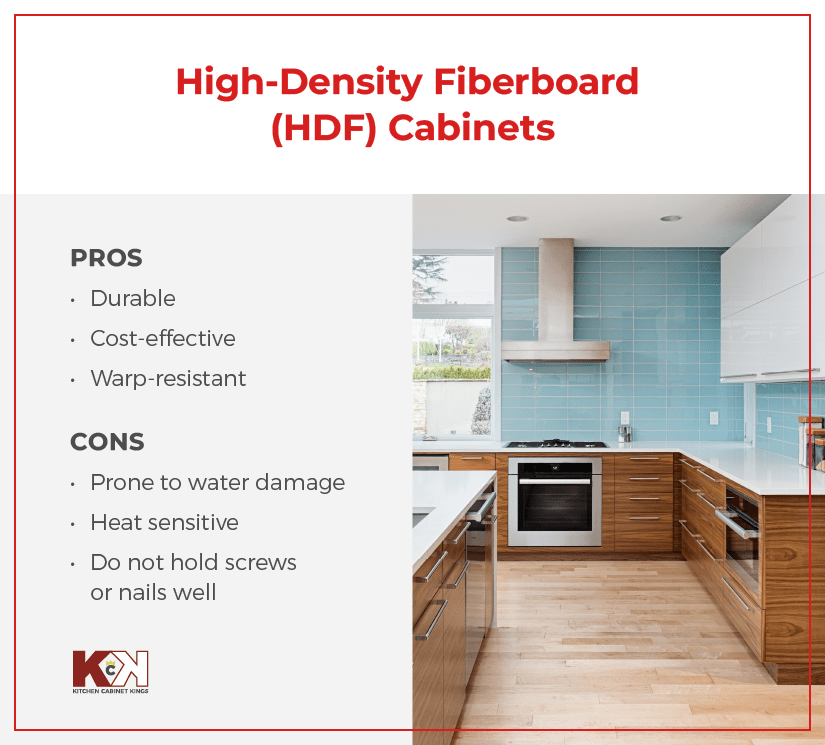
High-density fiberboard is one of the best materials for kitchen cabinets if you're looking for an affordable and durable option. HDF is an engineered wood made with a mixture of wood fiber, real wood, resin, and adhesives formed under immense pressure and heat. It's a step above MDF in terms of hardness and durability, making it more comparable to solid wood.
HDF cabinets take the best of both solid wood and MDF, boasting a smooth, paint-ready finish that's resistant to warping and cracking. Because of the extensive manufacturing process, HDF cabinets are more expensive than MDF cabinets, but still cheaper than solid wood.
Pros:
 Hardness and durability comparable to solid wood
Hardness and durability comparable to solid wood More affordable than solid wood
More affordable than solid wood Stable in humid and dry conditions
Stable in humid and dry conditions Ideal for painting
Ideal for painting Resistant to warping and cracking
Resistant to warping and cracking
Cons:
 Prone to water damage
Prone to water damage Do not hold screws or nails well
Do not hold screws or nails well Sensitive to extreme heat
Sensitive to extreme heat Not as strong as plywood
Not as strong as plywood
5. Particle Board
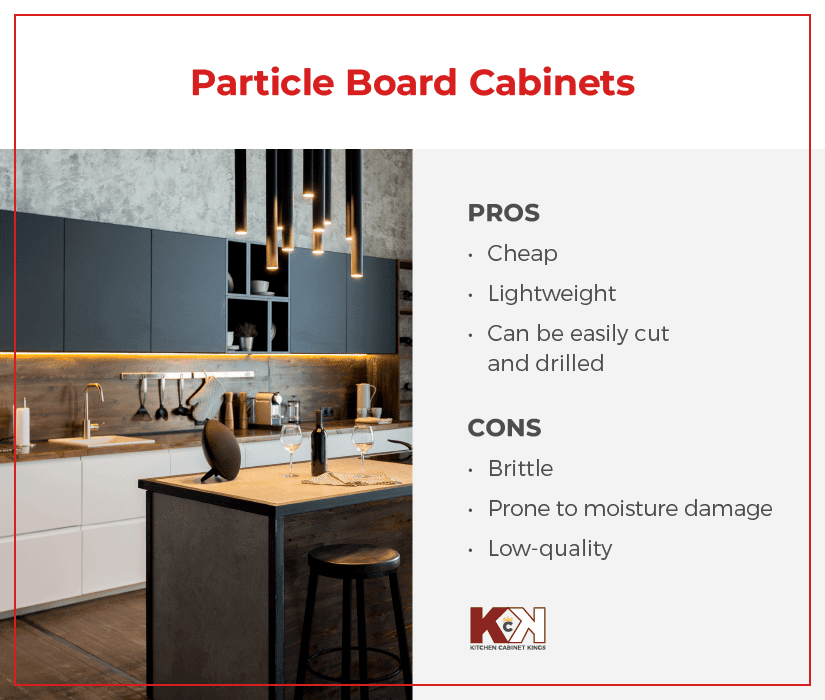
The cheapest cabinet material available is particle board. It's made by compressing resin, wood chips, and sawdust to form rigid sheets or panels, often coated with a laminate or vinyl veneer. Particle board is lighter than MDF and can be easily drilled, cut, milled, or glued - but the advantages stop there.
If you decide to save money with particle board cabinets, keep in mind that this material is not very durable and should be handled with care. Compared to plywood or MDF cabinets, particle board is more prone to moisture damage and can expand, warp, and discolor. Particle board is also softer and more brittle than other engineered wood types, so if you're known to bang, slam, or bump your cabinets, you may want to avoid this material.
Pros:
 Cheapest cabinet material
Cheapest cabinet material Lightweight
Lightweight Hold screws better than MDF and HDF
Hold screws better than MDF and HDF
Cons:
 Prone to moisture damage
Prone to moisture damage Susceptible to cracks
Susceptible to cracks Low-quality
Low-quality
6. Laminate
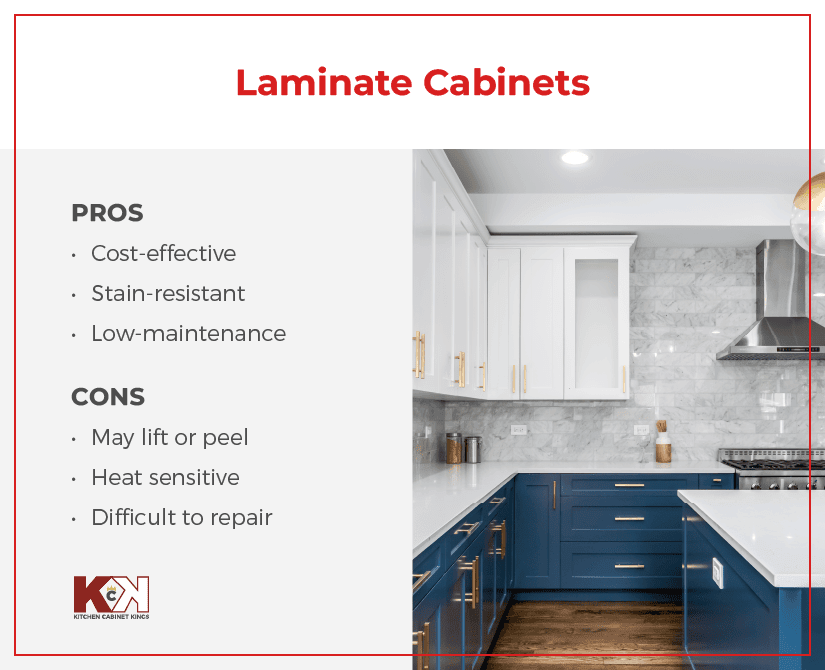
If you opt for an engineered wood cabinet material, you'll also need to decide what sort of veneer works best for your space. Most stock and semi-stock cabinets are wrapped in some sort of laminate to conceal and protect the cabinet core while providing plenty of color and pattern options.
The quality of laminate surfacing can vary depending on how much pressure is applied to the surface during manufacturing. High-pressure laminate (HPL) presses paper and resin together under 1400 PSI to create a smoother, seamless cabinet finish that's less likely to chip or crack. Low-pressure laminate costs less but is not as durable.
Pros:
 Affordable
Affordable Stain-, heat-, and scratch-resistant
Stain-, heat-, and scratch-resistant Low-maintenance
Low-maintenance
Cons:
 Prone to chips and cracks
Prone to chips and cracks May lift or peel
May lift or peel Sensitive to extreme heat
Sensitive to extreme heat Difficult to repair
Difficult to repair
7. Melamine
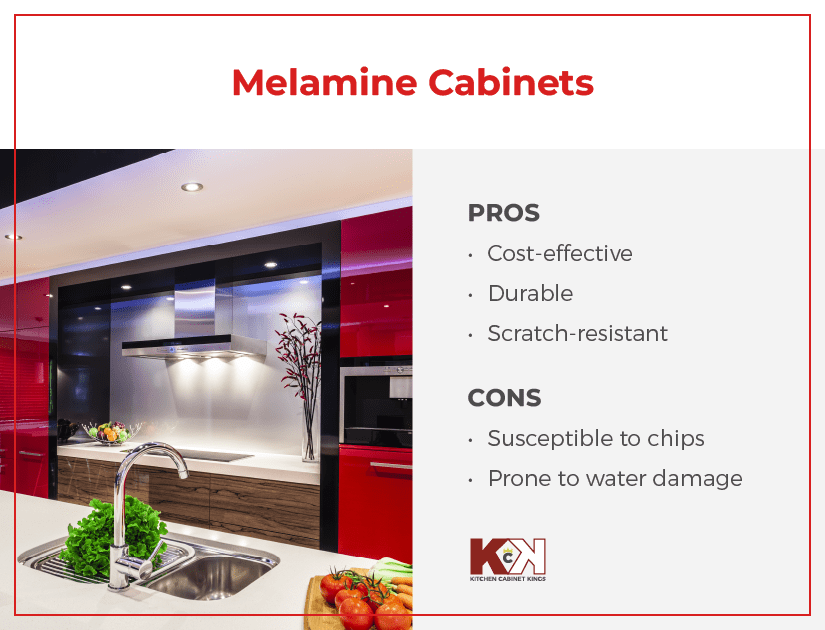
Melamine is a type of laminate used to cover an engineered wood board. It's applied by heat-sealing paper saturated with thermally fused melamine resin (TFM) to create a highly durable surface. Melamine cabinets are scratch-resistant, colorfast, come in a variety of textures, and can last for decades if kept in good condition.
Of course, a higher-quality laminate comes with a higher price tag. The cost for a set of melamine cabinets in a 10'x10' kitchen can range between $1,000 and $4,000, depending on the quality of the finish and the type of core material used for construction. Like all cabinets made from engineered wood, melamine cabinets also have the potential for water damage that can be tricky to repair. And although melamine won't crack or split like natural wood, the finish can chip and expose the rough cabinet core.
Pros:
 Cost-effective
Cost-effective Durable
Durable Large variety of colors and textures
Large variety of colors and textures Scratch-resistant
Scratch-resistant Won't discolor or fade
Won't discolor or fade
Cons:
 More expensive than thermofoil cabinets
More expensive than thermofoil cabinets Susceptible to chips
Susceptible to chips Prone to water damage
Prone to water damage
8. Thermofoil

Thermofoil is a type of vinyl used to conceal MDF or HDF cabinet doors and drawer fronts. This type of cabinet material comes in virtually every color, finish, and style, so you'll be able to find a set of affordable cabinets that match your design perfectly.
In addition to their seamless look and feel, thermofoil cabinets are known for their superior moisture resistance and durability. You won't have to worry about warping or swelling in high-humidity environments thanks to the MDF core. However, thermofoil cabinets have a short life span - about 10 years - before they start to yellow and chip. If you enjoy switching up your space often and don't mind replacing your cabinets in a few years, thermofoil cabinets are a cost-effective way to incorporate chic, trendy colors into your design.
Pros:
 Affordable
Affordable Huge selection of colors and styles
Huge selection of colors and styles Low-maintenance
Low-maintenance Moisture-resistant
Moisture-resistant Moisture-resistant
Moisture-resistant Warp-resistant
Warp-resistant
Cons:
 Prone to heat damage
Prone to heat damage Difficult to repair
Difficult to repair Prone to discoloration
Prone to discoloration Known to peel or chip
Known to peel or chip Short life span compared to other manufactured cabinet materials
Short life span compared to other manufactured cabinet materials
9. Polyester
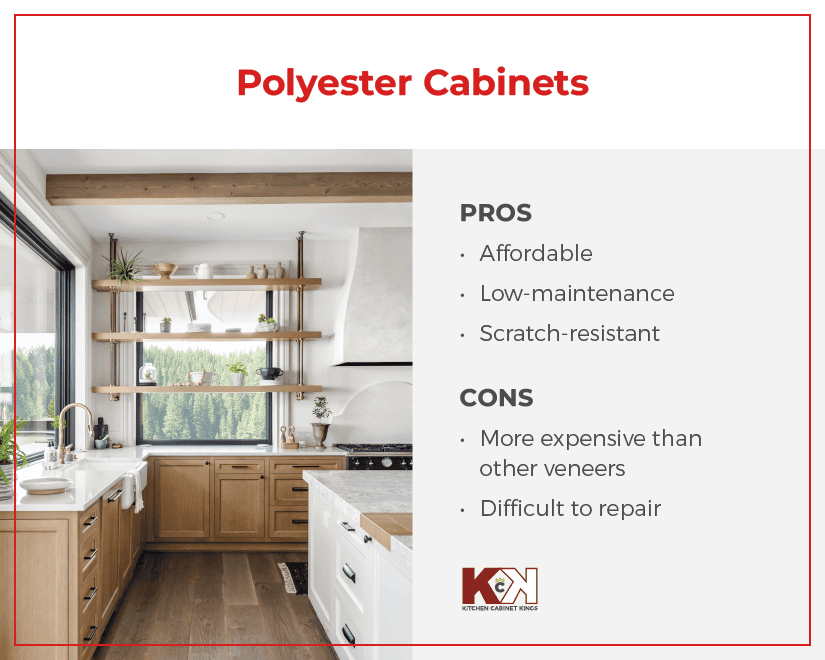
Polyester is a faux wood cabinet veneer that blends pine fiber and melamine to replicate the look and feel of solid wood. The mixture is topped with a polyester film, so the cabinets not only look like real wood, but are nearly as durable and scratch-resistant.
Unlike real wood or wood veneer, polyester cabinets are easy to maintain and less likely to discolor or fade over time. However, this cabinet material comes at a premium price compared to melamine or laminate.
Pros:
 More cost-effective than solid wood
More cost-effective than solid wood Low-maintenance
Low-maintenance Scratch-resistant
Scratch-resistant Available in a wide range of colors and wood looks
Available in a wide range of colors and wood looks Won't fade or discolor
Won't fade or discolor
Cons:
 More expensive than laminate or melamine
More expensive than laminate or melamine Difficult to repair or retouch
Difficult to repair or retouch
10. Wood Veneer
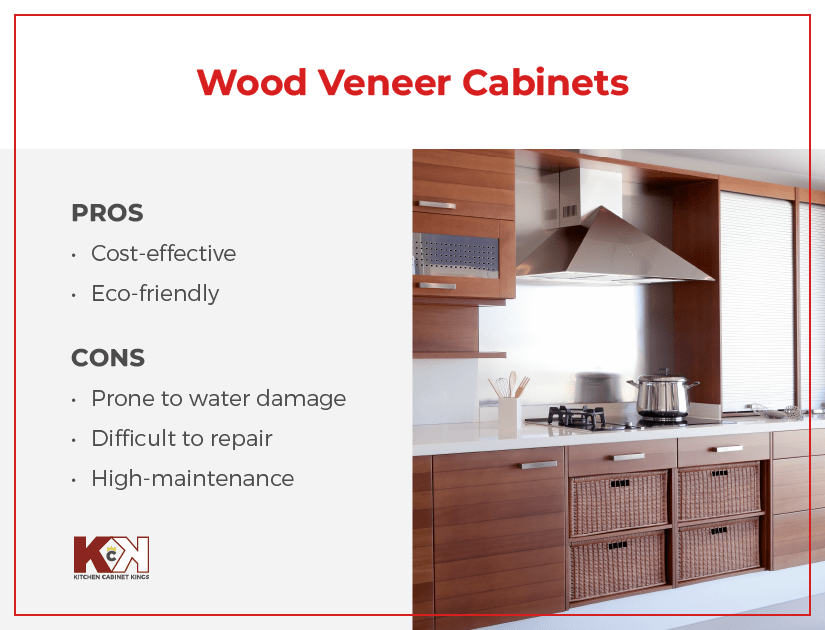
If solid wood cabinets are a bit out of your price range, you can still get the look with wood veneer. Wood veneer is a thin strip of solid wood that attaches to an engineered wood board to create wood-like panels. You'll get the same color, texture, and grain pattern as any solid wood cabinet of your choice - typically at half the cost.
Wood veneer cabinets range from $2,500 to $6,000 for a 10'x10' kitchen, making them a great affordable alternative for solid wood cabinets. However, these types of cabinets have their own unique set of drawbacks. In addition to being prone to water damage, wood veneer cabinets are nearly impossible to refinish or repair once damaged. Because the veneer is so thin, you can't sand and restain these cabinets like you could with solid wood.
Pros:
 Mimic the look and feel of natural wood
Mimic the look and feel of natural wood Affordable
Affordable Eco-friendly
Eco-friendly
Cons:
 Prone to water damage
Prone to water damage High-maintenance
High-maintenance Difficult to repair once damaged
Difficult to repair once damaged
11. Stainless Steel
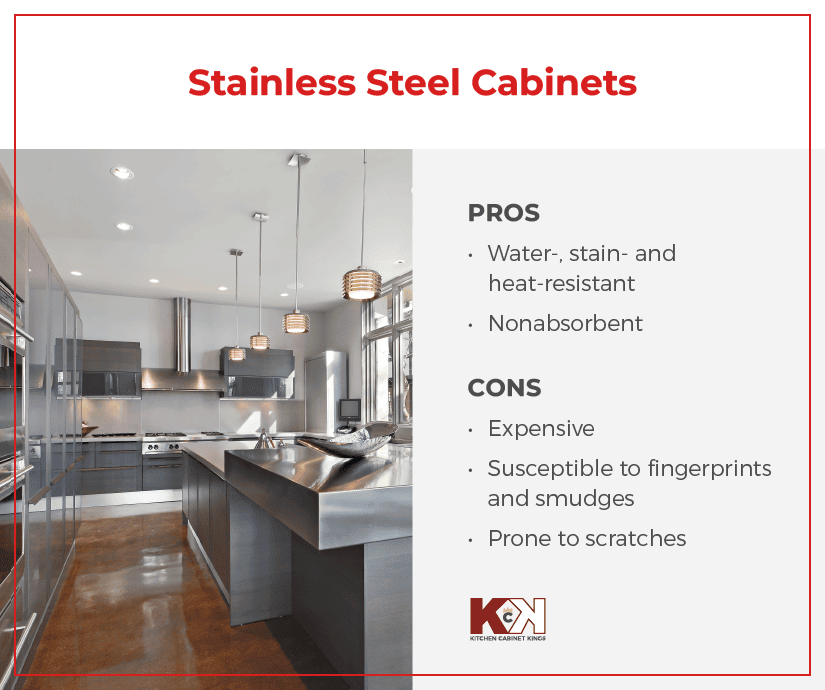
Stainless steel cabinets are often found in professional or commercial kitchens, but they've recently made a statement in the modern kitchen design scene. Revered for its sleek, industrial appearance, stainless steel is the perfect choice for aspiring home chefs looking for an easy-to-maintain cabinet material that'll hold its own against spills, burns, stains, and rust.
Aesthetically speaking, metal cabinets aren't for everyone. Some people believe stainless steel lacks warmth and comfort, but for those leaning toward a more contemporary design, this may be a nonissue. However, stainless steel cabinets come with a high price tag -if your heart is set on this nontraditional cabinet alternative, expect to spend about $25,000-$40,000 on your new cabinets.
Pros:
 Modern sleek appearance
Modern sleek appearance Water- and rust-resistant
Water- and rust-resistant Stain-resistant
Stain-resistant Heat-resistant
Heat-resistant Nonabsorbent and easy to clean
Nonabsorbent and easy to clean Will not dull over time
Will not dull over time
Cons:
 Most expensive cabinet material
Most expensive cabinet material Lower-quality steel is prone to dents and scratches
Lower-quality steel is prone to dents and scratches Industrial aesthetic may lack warmth
Industrial aesthetic may lack warmth Susceptible to fingerprints and smudges
Susceptible to fingerprints and smudges Tend to show more dirt than other materials
Tend to show more dirt than other materials
How To Choose the Best Type of Cabinet Material for Your Space
Ready to start shopping for your new cabinets? Here are a few tips to help you choose the right cabinet material for your remodel.
Evaluate Quality
No matter which cabinets you choose, pay attention to the quality of the materials and construction. You may be surprised to find some plywood stock cabinets made with the same luxury features as solid wood cabinets, such as dovetail joints and soft close drawers. On the other hand, even the most expensive solid wood cabinets can lack quality if the finish has been rushed or the cabinet box is held together with cheap plastic brackets.
Check the reviews and reach out to the manufacturer to ensure you're getting your money's worth on your new cabinets.
Go for Durability
If you're an active chef or share a home with curious children or rambunctious pets, consider emphasizing durability over price. Kitchen cabinets can be an expensive investment, but settling for cheap materials that won't be able to withstand your household's regular wear and tear may end up costing you more in the long run.
Affordable cabinet materials like plywood or high-density fiberboard will be able to offer you the strength and durability you need without having to splurge on solid wood cabinets. All our cabinets are constructed with 100% Grade A plywood, so you can enjoy that new-kitchen feel for years to come.
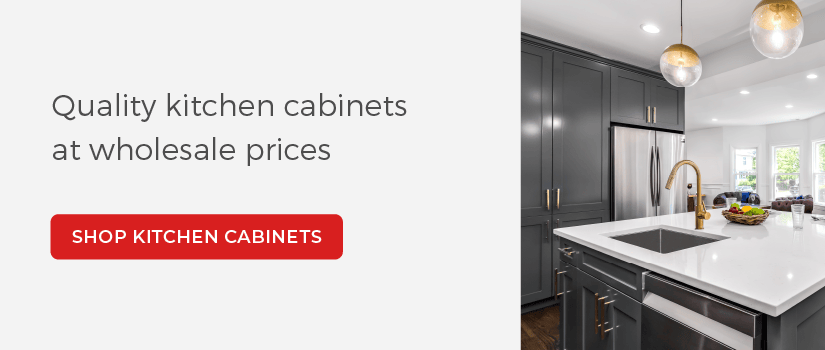
Compare Costs
Cost will likely be the biggest factor when it comes to choosing a kitchen cabinet material for your next remodel. If you're wondering what an appropriate budget is for new kitchen cabinets, experts recommend setting aside 15% of your home's total value on your kitchen remodel, with 30% of that sum going toward new cabinetry.
Use our handy kitchen remodel cost estimator for a complete breakdown of what you can expect to spend on your kitchen renovation.
Types of Cabinet Materials FAQs
Still weighing the kitchen cabinet materials pros and cons? We answered a few of the most frequently asked questions to help you make your decision.
What is the most durable type of kitchen cabinet material?
Solid wood is the most durable kitchen cabinet material, followed by plywood and high-density fiberboard. However, solid wood is prone to warping and cracking if exposed to wet, humid environments.
What's better for cabinets: MDF or plywood?
Plywood is more durable than MDF, making it a higher-end option. However, MDF is more affordable.
What materials are cheap cabinets made from?
Cheap kitchen cabinets are typically mass-produced using medium-density fiberboard or some other type of engineered particle board.
Finding the perfect kitchen cabinets for your home can be challenging, especially considering all the different types of materials to choose from. At Kitchen Cabinet Kings, we carry the best selection of 100% Grade A plywood cabinets so you can rest assured you're getting high-quality cabinets that will last for years to come.






